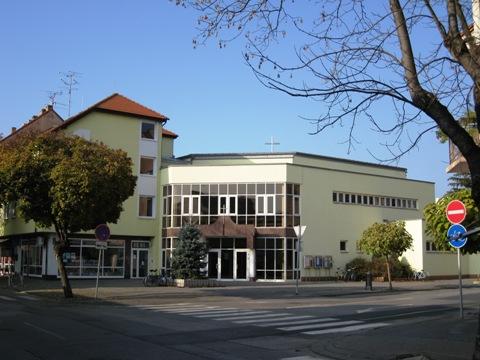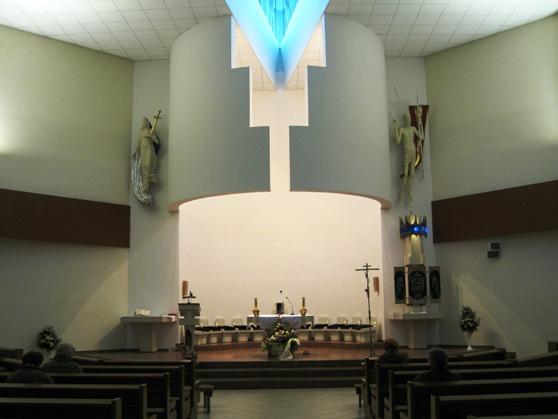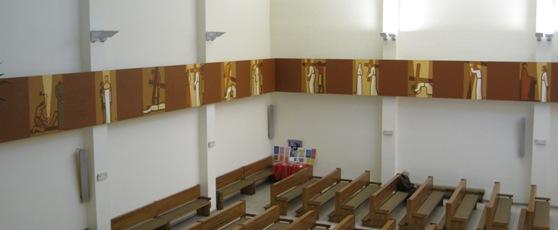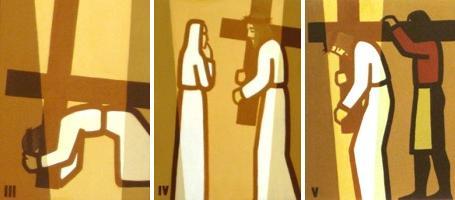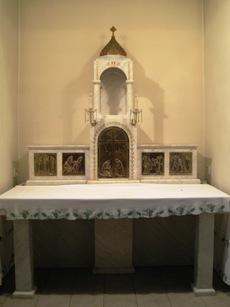 Web Content Display
Web Content Display
Kaplnka Sedembolestnej Panny Márie
pri dome Spoločnosti Ježišovej
Na mieste kaplnky kedysi stála stará Župná nemocnica, ktorú v roku 1942 jezuiti začali prestavovať na kaplnku a niekoľko bytov. V tejto podobe objekt slúžil až do roku 1997.
Na jej mieste vyrástol nový kostol posvätený 11. 10. 1997 a exercičný dom. Aj kostol je zasvätený Sedembolestnej Panne Márii. Stavbe však z tradície zostal titul kaplnky, i keď má rozmery a atribúty kostola.
Z histórie kaplnky
To že kaplnka dnes stojí na svojom mieste, je okrem Božej pomoci aj ukážkou vytrvalosti a obetavosti mnohých ľudí.
Ľudovít Winter, vtedajší riaditeľ a nájomca kúpeľov, v rokoch 1933 – 1934 vypracoval plán, podľa ktorého sa malo v Piešťanoch, v časti Floreát, postaviť gymnázium, kostol a internát, ktoré by zveril do starostlivosti niektorej rehoľnej spoločnosti. Žiaľ, plán sa nezrealizoval pre nedostatok dostupných odborníkov. S viceprovinciálom slovenskej SJ (Spoločnosť Ježišova, ľudovo „jezuiti") P. Rudolfom Mikušom sa však dohodli, že k plánom sa môžu vrátiť neskôr.
Rozrastajúcim sa Piešťanom chýbal najmä nový kostol, pretože starý kapacitne nestačil a bol aj ďaleko od nových mestských štvrtí. Pán Winter teda pokračoval v organizačných prípravách.
27. 2. 1939 Obecná rada v Piešťanoch vyhovela žiadosti Katolíckej školskej stolice o stavbu jezuitského kláštora. Obecná rada rozhodla o darovaní pozemkov na tento účel o výmere 6000 m2 „na Váhovom rade" (juhovýchodný okraj mesta). Pozemok však nebol dobre situovaný a centrum mesta by bolo naďalej bez kostola. Malá „kúpeľná kaplnka" pri sklenenom moste bola primalá, aby suplovala funkciu kostola pre obyvateľov centra.
Provinciál P. Rudolf Mikuš však rozhodol, aby sa jezuita P. Ľudovít Eiselle po dohode s dekanom Šindelárom natrvalo usadil v meste, s úlohou pripraviť založenie domu SJ a stavbu kostola.
25. 9. 1939 vystavil apoštolský administrátor ThDr. Pavol Jantausch poverovaciu listinu, v ktorej dáva súhlas na zriadenie rehoľného domu. S pozemkom pre kostol však boli naďalej problémy. Ako vhodné miesto pre kláštor a kostol sa javil objekt Vojenského kúpeľného ústavu, ktorý bol pomerne málo využívaný vojakmi. Prebehlo niekoľko rokovaní zástupcov mesta, štátu aj cirkvi.
P. Eiselle dal na žiadosť Ministerstva národnej obrany vypracovať projekt kostola architektovi B. Szönyimu a prof. Wimmerovi. Padlo niekoľko prísľubov, ale nakoniec sa 11. 3. 1941 ukázalo, že vojaci len naťahovali čas a robili obštrukcie. Jezuitom tým však spôsobili nemalé finančné výdavky. Zámer s Vojenským kúpeľným ústavom sa teda nepodarilo zrealizovať.
Medzitým zámer už nemohli podporovať bratia Winterovci, lebo boli vo vyšetrovacej väzbe v Bratislave pre ich židovskú minulosť, hoci v tej dobe boli už vyše 30 rokov pokrstení a v Slovenskom štáte dostali prezidentskú výnimku z protižidovských zákonov. Aj keď ich 18. 3. 1941 prepustili z väzenia, mladší z nich ochorel a druhý sa najprv z obavy pred represáliami skrýval a napokon ho aj tak internovali v záchytnom tábore v Seredi a deportovali do koncentračného tábora Terezín v Čechách. Starší sa dožil konca vojny a istý čas pôsobil ako zamestnanec firmy Floreat, ktorú sám založil. Po nastolení marxistického režimu sa však čoskoro dostal do nemilosti komunistov a v roku 1949 ho prepustili z práce.
Po dlhších rokovaniach s Ministerstvom vnútra a Ministerstvom financií sa ako vhodné miesto ukazovala stará Župná nemocnica. Prezidiálny šéf Ministerstva vnútra, Dr. Izidor Koso, priznal, že táto pomerne malá nemocnica je zastaraná a štát na ňu iba dopláca, že pre štát by bol jej odpredaj výhodný, hoci aj za nižšiu cenu.
3. 1. 1942 zástupcovia Ministerstva vnútra odovzdali pozemok a budovy Župnej nemocnice do správy a užívania Spoločnosti Ježišovej. Garantom finančnej úhrady mala byť obec Piešťany.
P. Eiselle so spolupracovníkmi urobili z dvoch väčších miestností kaplnku s kapacitou asi 500 ľudí a v obytnej časti upravili tri izby. Na plánovanie a vykonanie stavebných prác sa podujal pán staviteľ Brokeš, stolárske práce robil pán Vavro a maliarske pán Guriš.
Pôvodný oltár darovali pátrom jezuitom sestry uršulínky z Trnavy. Do Piešťan ho priviezli 19. 1. 1942. Začiatkom marca zavesili na dvore pri kaplnke malý, ale zvučný zvon.
Kaplnka sa zakrátko naplnila, a ani tri nedeľné omše nestačili. Preto v letnom období slúžili omše na dvore, kde sa vošlo oveľa viac ľudí. Organ a organistu chránil košatý orech uprostred dvora, veľa ľudí však stálo priamo na slnku.
Ťažkosti sa však ešte nekončili. Na základe predbežných odhadov očakávali jezuiti platbu za schátraný a neužitočný objekt 100 000 až 200 000 korún. 7. 5. 1942 sa však dozvedeli, že Ministerstvo vnútra žiada 600 000 korún. To však bola suma, ktorú nemohli uhradiť ani jezuiti, ani obec ako garant kúpy. Nastalo horúčkovité vyjednávanie a vysvetľovanie pôvodných podmienok pozvania jezuitov do Piešťan, doložených zápisnicou z 20. 4. 1935. Napokon sa celý prípad priaznivo doriešil v marci 1943, keď sa Ministerstvo vnútra uspokojilo so sumou 150 000 korún. Sumu nakoniec zaplatila obec ako svoj príspevok na stavbu nového kostola.
Keď bol objekt vo vlastníctve rehole, mohli sa začať práce na zväčšení kaplnky. Kaplnka dostala podobu písmena L a bola takto činná až do roku 1997. V dome sa nadstavili aj manzardky, ktoré slúžili pre ubytovanie jezuitov. Na prestavbu prispel Župný úrad v Trenčíne sumou 50 000 korún. Stavebným robotníkom pomáhali aj väčší miništranti a ženy z mesta. Nová kaplnka mohla prijať až do 900 ľudí už v novembri 1943.
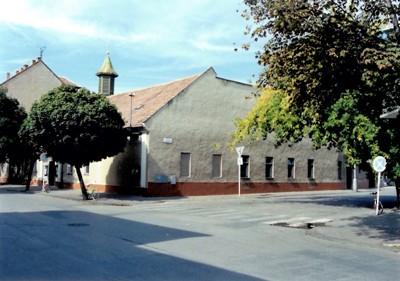 |
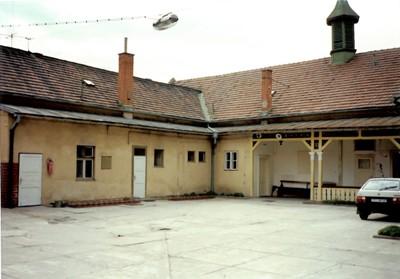 |
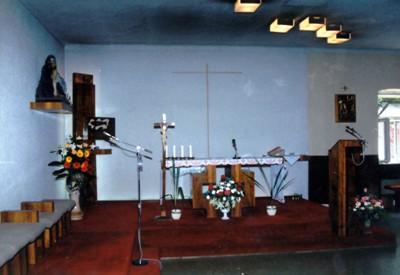 |
Vdp. Alexander Šindelár, miestny dekan, vysvätil kaplnku Sedembolestnej Panny Márie 14. 11. 1943.
O naliehavej potrebe kaplnky svedčí fakt, že ju ľudia dostatočne napĺňali napriek tomu, že cez sviatok v nej slúžili 4 omše a vo všedný deň 2.
Kaplnka bola ohrozená aj na sklonku 2. svetovej vojny. Ustupujúci nemeckí vojaci dostali príkaz vyhodiť do vzduchu budovu starej pošty v tesnom susedstve. Keď ich Piešťanci prosili, aby to nerobili, vojaci im vysvetlili, že keby neposlúchli príkaz, postrieľali by ich. Vojaci dokonca začali hĺbiť šachtu na trhaviny. Z neznámych dôvodov však nakoniec iba zničili ústredne, ale budovu nechali stáť. Len okná na kaplnke rozbil výbuch na sklenenom moste vzdialenom asi kilometer.
Od roku 1946 bol zriadený Prípravný výbor pre stavbu nového kostola, ktorý zhromažďoval milodary na stavbu nového kostola. Bola založená Mariánska kongregácia, počas 2. svetovej vojny tu bol istý čas umiestnený Teologický inštitút SJ, ktorý sa musel presťahovať z "partizánskej" Banskej Bystrice.
Študenti usporadúvali akadémie a hrali divadlá z ktorých výťažok venovali na stavbu kostola. Do dvora sa už privážal aj materiál na nový kostol.
13. 4. 1950, krátko pred polnocou, komunisti so zbraňami v ruke násilne ukončili činnosť rehole. Odviezli všetkých rehoľníkov a skonfiškovali aj financie na stavbu nového kostola vyzbierané ako milodary.
V roku 1968 sem prišiel P. Michal Petráš SJ, ktorý spravoval kaplnku do roku 1972. Potom mu komunisti v rámci "normalizácie" odobrali štátny súhlas. V roku 1971, v rámci liturgickej obnovy podľa záverov II. vatikánskeho koncilu, farský úrad zabezpečil pre kaplnku nové liturgické zariadenie, elektrifikáciu a vymaľovanie. Priľahlé budovy rezidencie slúžili ako rekreačné zariadenie pre kňazov a cirkevných zamestnancov.
Systematická pastorácia bola obnovená až 6. januára 1990, kedy sem prišiel ako prvý P. Ján Revák SJ, ktorý spolu s P. Jozefom Porubčanom SJ a P. Michalom Potockým SJ začali písať nové dejiny piešťanskej komunity. Exercičný dom v Piešťanoch stal známym na celom Slovensku. A to aj napriek nevyhovujúcim priestorovým podmienkam.
V roku 1995 vedenie slovenskej provincie SJ rozhodlo, že sa konečne splní plán P. Eiselleho SJ. Bol postavený nový komplex, ktorý zahŕňa stavbu nového kostola aj exercičného domu. Kostol posvätil 11. 10. 1997 J. E. Mons. Dominik Tóth a exercičný dom J. E. Mons. Vladimír Filo 26. 5. 2000.
Stará kaplnka bola v prevádzke dokonca aj počas prvej fázy výstavby nového kostola, ktorý stojí na jej mieste.
Súčasnosť
Aj nový kostol je zasvätený Sedembolestnej Panne Márii. Podľa tradície sa však stále volá kaplnkou.
Autormi stavby sú Ing. arch. Ľubomír Mrňa a Ing. arch. Marcel Kajlich. Liturgické zariadenie je od architekta Ľudovíta Chmelára. Sochy Panny Márie a zmŕtvychvstalého Ježiša (umiestnené z ľavej a pravej strany nad oltárom) od Doc. Akad. sochára Milana Lukáča.
Krížovú cestu namaľoval akademický maliar Ladislav Záborský v roku 1997.
Eklektický bočný oltár je ponechaný zo starej kaplnky.
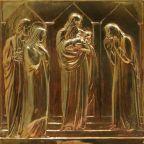 | 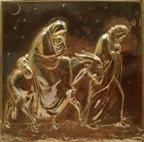 |  | 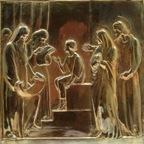 | 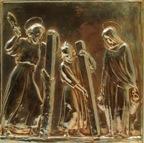 |
Snaha o vybudovanie exercičného domu vzišla z exercičných tradícií jezuitov. Snažili sa vytvoriť čo najlepšie vonkajšie podmienky pre tých, ktorí si chcú usporiadať svoj život v súlade s Božou vôľou. A tak majú dnes k dispozícii exercičnú kaplnku, kuchyňu a jedáleň. Exercitanti sú ubytovaní v 29 jednoposteľových izbách. Každá izba má svoje samostatné sociálne zariadenie.
Exercície tu absolvuje priemerne viac ako 1000 veriacich za rok, vrátane kňazov a rehoľníkov.
Až do postavenia nového farského kostola sv. Cyrila a Metoda patrila kaplnka k najnavštevovanejšiemu kostolu v Piešťanoch, lebo starý farský kostol je v Starých Piešťanoch, pomerne ďaleko od centra. Kaplnka je známa aj každodenným spovedaním pri každej sv. omši, čo radi využívajú nielen veriaci z Piešťan, ale aj z okolia.
Viac o Spoločnosti Ježišovej v Piešťanoch nájdete na ich domovskej stránke.
Použitá literatúra:
Ľudovít Chmelár-Hlohovský: Piešťanský dekanát. Magma, 2003, 58-59
Rajmund Onduš, SJ: P. Ľudovít Eiselle, SJ – Svedok a služobník generácií. Dobrá kniha, 2000
 Kostoly farnosti
Kostoly farnosti
Piešťany
- Kostol sv. Cyrila a Metoda
(Nitrianska ulica) - Kaplnka Božského Srdca Ježišovho
(kúpeľná kaplnka pri sklenenom moste, Winterova ulica) - Kaplnka Sedembolestnej Panny Márie
(pri dome SJ, Poštová ulica) - IX. základná škola (Sv. omše sú dočasne zrušené!!!)
(sídlisko Adam Trajan, ulica E. F. Scherrera)
Filiálka Banka
Filiálka Kocurice
 Mapa
Mapa
